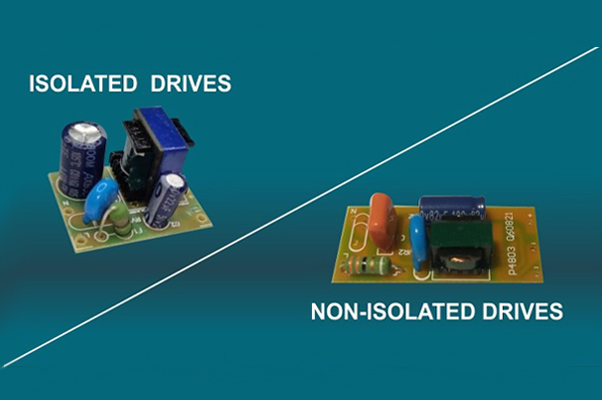The LED driver is a crucial component that converts AC power to DC power for LED lighting fixtures. When choosing LED drivers, you often encounter two types: isolated and non-isolated. This article will explore the characteristics, advantages, and applications of both types to help users better understand them.
Isolated LED Driver:
Isolated LED drivers utilize one or more isolation components, typically transformers, to separate the input and output circuits. This means there’s no direct electrical connection between the output and input terminals, achieving electrical isolation. Here are the key features:
- High Safety: With electrical isolation between the output and input terminals, isolated LED drivers offer enhanced safety by significantly reducing the risk of electric shock, ensuring user safety.
- Strong Interference Resistance: Electrical isolation prevents interference signals from the input side propagating to the output side, enhancing the driver’s resistance to interference and ensuring stable operation of LED fixtures.
- Wide Applicability: Isolated LED drivers are suitable for various applications, particularly those requiring high electrical safety standards, such as residential and commercial lighting.
Non-Isolated LED Driver:
In contrast, non-isolated LED drivers lack electrical isolation, with the output circuit directly connected to the input circuit. While simpler and more cost-effective, they possess the following characteristics:
- Cost-Effectiveness: The absence of isolation components makes the design of non-isolated LED drivers simpler and more cost-effective, making them suitable for cost-sensitive applications.
- Versatility: Non-isolated LED drivers can be used in various applications, especially those with lower safety requirements and cost considerations, such as industrial and outdoor lighting.
- Voltage Fluctuations: Due to the lack of electrical isolation, non-isolated LED drivers may experience voltage fluctuations at the output terminal directly influenced by input voltage variations, potentially leading to output voltage instability.
Selecting the Right LED Driver:
When choosing LED drivers, it’s essential to consider specific application requirements and safety standards. For applications demanding high safety standards like residential and commercial lighting, isolated LED drivers are recommended. For applications with lower safety requirements and cost considerations like industrial and outdoor lighting, non-isolated LED drivers may be suitable.
Differentiating Between Isolated and Non-Isolated LED Drivers:
Isolated and non-isolated LED drivers can typically be distinguished by certain features in their appearance or labeling. Here are some common indicators:
Isolated LED Driver:
- Labeling: Products may be marked with terms like “Isolated” or similar on the housing or specification sheet to indicate electrical isolation.
- Housing Design: Isolated LED drivers may have larger housings to accommodate isolation components like transformers. Additionally, safety symbols like electrical isolation symbols may be present on the housing.
- Terminal Identification: Input and output terminals of isolated LED drivers may be labeled on the housing to differentiate electrical isolation.
Non-Isolated LED Driver:
- Labeling: Similar to isolated drivers, products may be labeled with terms like “Non-isolated” or similar to indicate the lack of electrical isolation.
- Housing Design: Non-isolated LED drivers often have smaller housings due to the absence of isolation components. Additionally, there may be no additional safety markings on the housing.
- Terminal Identification: While input and output terminals may be labeled, there won’t be an emphasis on electrical isolation as there are no isolation components.
It’s important to note that while these features can help distinguish between isolated and non-isolated LED drivers, consulting the product specification sheet and certification documents is the most reliable way to confirm whether a product offers electrical isolation.
